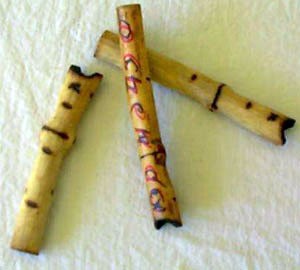Resource 6: Musical pipes
![]() Background information / subject knowledge for teacher
Background information / subject knowledge for teacher

Making and playing Tshikona pipes
Pipe ensembles are special music groups because each person plays only one note. However, put together, often in very complicated ways, this creates wonderful music. Every person is contributing a sound to a complex whole – it’s like democracy in music!
The VhaVenda, Batswana and Bapedi are known for their reed-pipe ensembles, which are said to accompany dances like the Venda Tshikona and Bapedi Dinaka. Pipes are either made by reeds (in rural areas) or metal pipes (in urban areas or the mines). The pipes vary in size from 20 cm to over a metre in length, producing a range of high and low notes.
This activity is based on Tshikona music and pipes played by the Venda people who live in the northernmost part of South Africa (Limpopo Province). Tshikona pipes are long pipes of different lengths, each one producing a different note. You can make your own pipes by using plastic piping such as electrical conduit, cutting plastic fax-paper pipes, or irrigation piping (12–15 mm diameter). Make pipes of different lengths so that you have different notes.
Making and playing your own pipes
Pipe ensembles are special music groups because each person plays only one note. However, put together, often in very complicated ways, this creates wonderful music.
Pipes can be made from reeds (in rural areas) or metal (in urban areas). Pipe length can vary from 20 cm to over 1 m, producing a range of high and low notes.
You can make your own pipes by using plastic piping such as electrical conduit, cutting plastic fax-paper pipes, or irrigation piping (12–15 mm diameter). Make pipes of different lengths so that you have different notes.
To play the pipes:
- Place the open side of the instrument level, against the lower lip.
- Hold the pipe between your fingers, the index and thumb.
- Relax your other fingers around the middle of the instrument.
- Begin to blow softly across the hole until a note is produced.
- Experiment with closing the bottom of the pipe with your hand.
You could also use different sized bottles and blow across the tops to produce sounds.
Resource 5: Pupil praise songs



